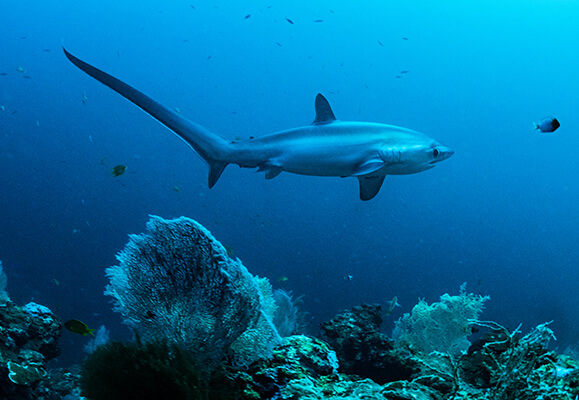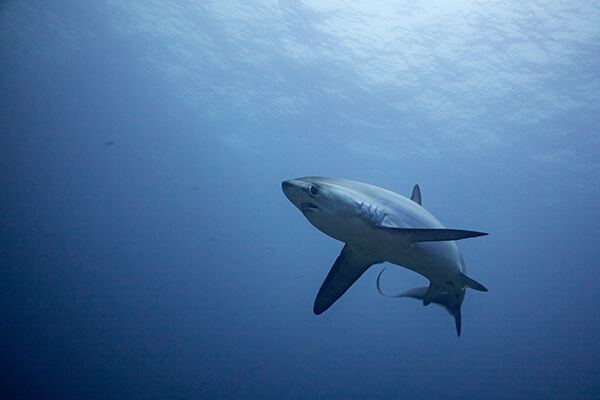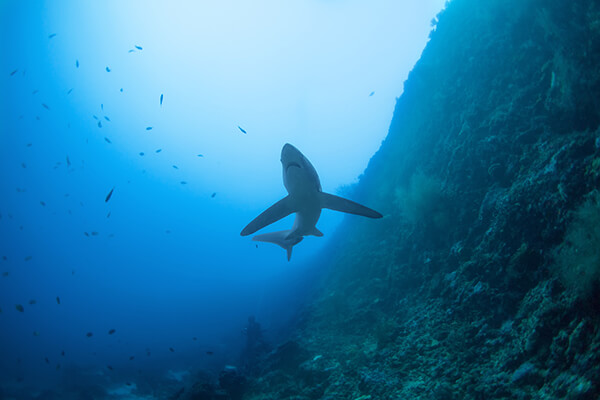
| Kingdom | Animalia |
| Phylum | Chordata |
| Class | Chondrichthyes |
| Order | Lamniformes |
| Family | Alopiidae |
| Genus | Alopias |
| Species | A. vulpinus, A. pelagicus, A. superciliosus |
| Niche | Pelagic Predator |
| Length | Up to 20 ft (6.1 m) |
| Weight | 1100 lbs (500 kg) |
| Lifespan | 20 years + |
| Social Structure | Solitary |
| Conservation Status | Vulnerable |
| Preferred Habitat | Temperate and Tropical Oceans |
| Average Litter Size | 2-4 |
| Main Prey Species | Schooling fish, squid, cuttlefish, crustaceans, sea birds |
| Predators | Larger sharks, orca |
The Basics
The Thresher shark is a genus of three shark species present in all of the world’s temperate and tropical oceans. They have long tails that can be as long as the body of the shark itself. Their head is short and cone-shaped with a small mouth and teeth.
The Common Thresher (A. vulpinus) is the largest of the three species, reaching a total length of 20 ft (6.1 m) and weighing over 1100 lbs (500 kg). The Big Eye Thresher (A. superciliosus) grows to about 16 ft (4.9 m) and the Pelagic Thresher (A. pelagicus) reaches about 10 ft (3 ft). They are slender and have small dorsal fins and large pectoral fins with skin color ranging from brown, blue, or purple-gray, depending on the species and water conditions, with lighter coloration on their dorsal side.

Thresher sharks are pelagic animals, meaning they swim freely in the water column as opposed to living on the bottom. They are largely solitary but occasionally hunt in small groups of 2 or 3 individuals. Thresher sharks use their long tail as a weapon to stun their prey, typically schooling fish, before turning around to eat the dazed prey. They may follow these schools into shallow inshore waters but otherwise are generally found in deeper waters. Threshers also eat various mollusks such as squid and cuttlefish. Sometimes they will also seek crustaceans near the seafloor or even seabirds from the surface. Their primary predators are larger shark species as well as orcas.
Thresher sharks are a prized game fish in the United States and South Africa and are the target of a sport fishery in Baja California, Mexico. They are also victims of the trade in shark meat and shark fins. This overfishing, combined with their slow development rate has resulted in Thresher sharks being listed as vulnerable to extinction by the IUCN since 2007.
There is no distinct thresher shark breeding season. Like many sharks, fertilization and embryonic development occur internally. Typically females give birth to a small litter of 2-4 large pups of up to 59 in (150 cm) that are slow to mature, becoming reproductive at between the ages of 7 and 14 years. Thresher sharks live for more than 20 years.

Are They Dangerous?
Thresher sharks belong to the order Lamniformes (from the Greek word, Lamna, “fish of prey”), which also includes the Great White shark. However, they are not a threat to humans due mostly to their relatively small size and mouths. They do not consume large prey of any kind so there is little chance of them confusing people with their natural prey, as is the case in most shark attacks. There have been zero recordings of Thresher sharks attacking humans.
Fun Facts about Thresher Sharks!
Thresher sharks share many characteristics with other shark species, which are great animals to explore various biological concepts due to their ancient lineage and large fossil records.
How Sharks Lurk in the Depths
Countershading, otherwise known as Thayer’s Law, is a type of crypsis or camouflaging observed throughout the animal kingdom in which the upper side of an animal is darker in color than the underside. It is an evolutionary adaptation that can be observed in mammals, reptiles, birds, fish, and insects in both predatory and prey species.
When light falls from above on a 3-dimensional object, it causes that object to appear lighter on its upper side than its underside, where some shadows may still obscure light. This makes the object easier to detect. In nature, being detected isn’t always a good thing. It can reduce an animal’s chances of surprising its prey. It can also increase the chances of being detected by its predators. This allowed countershading, which counters this phenomenon, to evolve throughout the animal kingdom.

Despite their varied coloration on their ventral side, all Thresher sharks have lighter coloration on their dorsal side. You might imagine looking up at the animal from below with the bright light of the sun as the backdrop. Alternatively, you may be looking down on the shark from above, with the dark depths of the ocean as the backdrop. In these scenarios, it is not hard to imagine how the lighter underside and darker top side of Thresher sharks would make them more difficult to be seen by both their predators and their prey.
Are Thresher Sharks Warm-Blooded?
Endotherms are animals that can retain some of their internal heat to maintain a metabolically favorable temperature. Typically, this occurs by retaining some of the heat produced by an organism’s internal organs rather than relying solely on ambient heat. You may often hear these animals referred to as ‘warm-blooded’.
At least two species of Thresher sharks use a modified circulatory system that allows them to retain some metabolic heat. Similar adaptations are observed in all mammals and birds, as well as tuna and billfishes. Shivering, which redirects blood to areas that generate heat, is an analogous example familiar to humans and other mammals.
By reducing the amount of heat wasted to the environment, the animal can operate more efficiently, allowing them to survive on less food than would otherwise be necessary. This is a clear evolutionary advantage.
